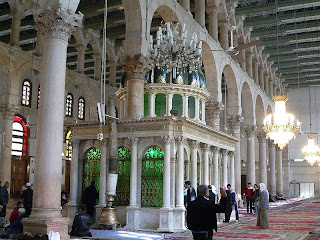Thursday, 2 December 2010
Saturday, 27 November 2010
Citadel of Damascus
Citadel of Damascus
Citadel of Damascus
قلعة دمشق
Damascus, Syria
| Type | Castle |
|---|---|
| Coordinates |  33°30′42″N 36°18′7″E / 33.51167°N 36.30194°E / 33.51167; 36.30194Coordinates: 33°30′42″N 36°18′7″E / 33.51167°N 36.30194°E / 33.51167; 36.30194Coordinates:  33°30′42″N 36°18′7″E / 33.51167°N 36.30194°E / 33.51167; 36.30194 33°30′42″N 36°18′7″E / 33.51167°N 36.30194°E / 33.51167; 36.30194 |
| Built | 1076–1078 and 1203–1216 |
| Built by | Atsiz bin Uvak |
| Construction materials | Limestone |
| In use | Until 20th century |
| Current condition | Partially ruined |
| Current owner | Directorate General of Antiquities and Museums (DGAM) |
| Open to the public | No |
| Controlled by | Atsiz bin Uvak (1076–1078) Seljuk dynasty (1078–1104) Burid dynasty (1104–1154) Zengid dynasty (1154–1174) Ayyubid dynasty (1174–1260) Mamluk Sultanate (1260–1516) Ottoman Empire (1516–1918) |
Courtyard and south wall of the Citadel of Damascus
The Citadel of Damascus , Qala'at Dimashq) is a large medieval fortified palace and citadel in the old city of Damascus, Syria. It is located in the northwest corner of the city walls of Damascus, between the Bab al-Faradis and the Bab al-Nasr, which is the current entrance to the Al-Hamidiyah Souq (market). The citadel consists of a more or less rectangular curtain wall enclosing an area of 160 by 240 metres (520 by 790 ft). The walls are flanked by thirteen towers. Three monumental gates give access to the courtyard
One of the bastions of the Citadel of Damascus""
.
Construction of the citadel was initiated in 1076 by the Turkman warlord Atsiz bin Uvak and finished by the Seljuk ruler Tutush I. The citadel was modified several times by later emirs of the Burid and Zengid dynasties during the 11th and 12th centuries. During this period, the citadel and the city were also besieged several times by Crusader and Muslim armies. In 1174, the citadel was captured by Saladin, the Ayyubid sultan of Egypt, who made it his residence and had its defences and residential buildings modified
.
.
Saladin's brother Al-Adil became emir of Damascus in 1196 and he rebuilt the citadel completely between 1203 and 1216, probably to counter new developments in siege warfare. After his death, power struggles broke out between the various Ayyubid princes. In this period, Damascus was attacked several times, but the citadel was taken by force only once in 1239. This period of instability ended when Al-Muazzam Turanshah, the last Ayyubid sultan of Egypt, was murdered in 1250. Damascus was seized by An-Nasir Yusuf, the Ayyubid ruler of Aleppo, who now controlled most of Syria. The Mongols under their general Kitbuqa captured Damascus in 1260, thereby ending Ayyubid rule in Syria. After an unsuccessful revolt broke out in the citadel, the Mongols had it largely dismantled.
The citadel is part of the Ancient City of Damascus, which was listed as a UNESCO World Heritage Site in 1979. Excavations and restorations have taken place in the citadel since 1986 and continue until today
Street along the northern wall of the citadel
Detail of a wall showing a small gate and a re-used stone.
Wednesday, 24 November 2010
Umayyad Mosque
Umayyad Mosque
The Umayyad Mosque, also known as the Grand Mosque of Damascus Ğām' Banī 'Umayya al-Kabīr), located in the old city of Damascus is one of the largest and oldest mosques in the world. It is considered the fourth holiest place in Islam.
After the Arab conquest of Damascus, the mosque was built on the Christian basilica dedicated to John the Baptist since the time of the Roman emperor Constantine I. The mosque holds a shrine which still today contains the head of John the Baptist (Yahya), honored as a prophet by both Christians and Muslims alike. There are also many important landmarks within the mosque for the Shī‘ah, among them is the place where the head of Husayn (the grandson of Muhammad) was kept on display by Yazīd I. There is also the tomb of Saladin, which stands in a small garden adjoining the north wall of the mosque.
In 2001 Pope John Paul II visited the mosque, primarily to visit the relics of John the Baptist. It was the first time a pope paid a visit to a mosque.
Subscribe to:
Comments (Atom)














